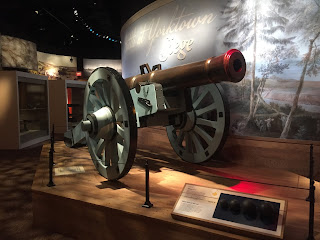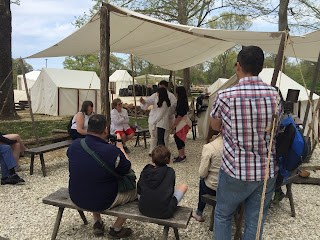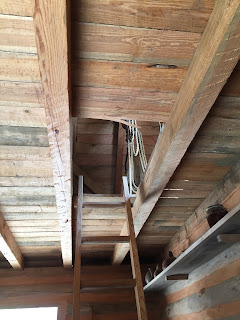Phone: (888) 593-4682 toll-free or (757) 253-4838
Hours: Open 9 a.m. to 5 p.m. daily
(until 6 p.m. June 15 through August 15). Closed Christmas and New
Year’s day
Ticket Price: Adult: $12.00, Youth
(6-12): $7.00, Ages 5 and under are free
Homeschool discount? Yes: Adult: $9.00,
Youth: $7.00; Can provide letter from county or homeschool ID to
receive discount.
Visited: Friday, April 14, 2017, 10:30
a.m. – 3:00 p.m.
What used to be the Yorktown Victory
Center recently received a major renovation and expansion, and it’s
now known as the American Revolution Museum of Yorktown. It is
administered by the Jamestown-Yorktown Foundation, an agency of the
Commonwealth of Virginia.
Upon entering the museum and purchasing
a ticket, the first stop is the theater. An introductory film,
“Liberty Fever,” introduces us to six participants in the
American Revolution – all with different backgrounds and different
perspectives. They include: The Boston Massacre in 1770, the battle
at Great Bridge in 1775, a family split by the Revolution in South
Carolina in 1780, a soldier at Princeton in 1777, a native American
soldier at Stono Ferry, South Carolina in 1779, and the Siege of
Yorktown in 1781.
Upon exiting the theater, we followed
the path through the exhibit halls. The story of the American
Revolution is told through many fascinating exhibits, many of them
interactive.
The exhibit halls depict: “The
British Empire in America,” “The Changing Relationship –
Britain and North America,” “Revolution,” “The New Nation,”
and “The American People.”
There were several smaller theaters throughout the exhibits, but the highlight was a visit to and experiential theater that transported us to the Yorktown battlefield in 1781. Not only were we surrounded by video, but we experienced wind, smoke/mist, and the thunder of cannons firing. It was an amazing experience and mustn’t be missed!
We enjoyed lunch in the café off the
entrance lobby. It was small, but offered a wide variety of
sandwiches, soups, chili, quiche, pizza, snacks, and huge desserts.
We were pleasantly surprised with the quality of the food. The café
has limited seating inside, but additional seating is available
outside when the weather is nice.
We resumed our tour in the outdoor
Continental Encampment and Farm areas. Here, costumed interpreters
are stationed in different areas to discuss everyday life during the
Revolutionary War period.
First, we visited the camp, which was
set up like a Revolutionary War camp. Our first stop was the
surgeon’s tent.
A table full of tools was on display, and we learned a great deal about surgery and medicine, as well as general information, there.
A table full of tools was on display, and we learned a great deal about surgery and medicine, as well as general information, there.
We do not have many written records of
the Revolutionary War. We do not know how many soldiers were killed.
We do have some letters that George Washington wrote to the
Continental Congress during the war. However, many of the records
were lost when the nation’s Capital moved from New York City to
Philadelphia, then from there to Washington D.C.
No surgeries were performed in camp –
George Washington knew surgery was a demoralizing factor, so he
forbid surgery in camp. He knew that seeing your friends and family
being operated on would be demoralizing. He wanted camp to be restful
instead.
The most common procedure performed was
musket ball extraction. The surgeon had to dig into the wound to pull
out the bullet. Many times, pieces of clothing and dirt also had to
be removed.
No anesthesia was used during surgery –
the patient was held down and fully aware of what was happening. No
alcohol was given to the patient either – George Washington didn’t
allow it in camp because he wanted the men to focus on battle. The
patients only had bite sticks to help distract them from their pain.
To bandage a wound, the surgeon could
either pack it with “lint” or wrap it with bandages.
Contrary to what many think, surgeons
during the Revolutionary War did wash their hands before and after
surgery. They did have time to do this, as opposed to Civil War
soldiers, who had many more patients and did not have time to wash
their hands. The Revolutionary War battles were much smaller than the
Civil War battles.
Even though they washed their hands and
instruments, they were not able to sterilize them, so the risk of
infection was high.
The surgeons amputated due to blood
loss and loss of function, not because of infection.
Infection and disease killed most
soldiers.
The Governer’s Palace in Williamsburg
was used to “cashier out” soldiers as well as a hospital for the
battle of Yorktown. 26 graves were found behind the Governor’s
Mansion – 24 soldiers and 2 women. These soldiers were the original
“American Veterans”.
The uniform’s jacket base color was
blue. The jacket’s trim tells where the soldier is from: Red
(Mid-Atlantic), Blue (Georgia), White (New England), or Tan (New York
State). The jacket’s epaulettes designate the rank, and the area
around the buttons indicate the type of soldier (infantry, etc.). The
buttons may say USA – some did, others did not. The hat had to be
black and folded, and 80% were folded three times. A piece of leather
was tied around the soldier’s neck – known as stock. This is the
origin of the term, “leatherneck,” as the Marines were formed
during this time.
Soldiers addressed George Washington
as, “His Excellency.”
We then moved to a camp kitchen /
cooking area. It was a circle trench dug out so that the cooks could
stand in the trench and cook on a fire at ground level. These areas
were away from the tents for safety reasons.
We then heard a whistle, which
indicated that the musket firing demonstration was soon to occur. We
went to the demonstration area to find a soldier with a flint lock
musket. He demonstrated the loading and firing for us, then
afterwards, anyone could go to the front to hold the gun and feel its
weight.
He said that muskets were used rather
than rifles, even though rifles were more accurate. Muskets were
cheaper to make and could be mass produced, vs. a rifle was custom
made for each owner. The muskets had bayonets on them, which were
used to intimidate the enemy more than anything.
By the Revolutionary period, several generations had lived on the property, and the focus was on improving buildings rather than building them. For many, this meant adding glass windows, covering the fireplace with brick, and covering the waddle and daub construction.
The farm had a few chickens.
The kitchen had an active fire going, and a batch of hot cross buns was ready to be baked.
A real pig’s foot was stored in salt to show us how meat was cured with salt for storage.
We visited a tool area, and then a tobacco barn.
Off to the side,
we could see a memorial but weren’t able to get to it from the farm
area. We decided to explore the parking area as we left.
It is a memorial for Nick and Mary Mathews, benefactors to the Jamestown-Yorktown Foundation who donated the land on which the museum is built and supported museum programs during their life and through their estate.
They had previously owned Nick’s Seafood Pavilion and donated the land on which the Museum now sits.
It is a memorial for Nick and Mary Mathews, benefactors to the Jamestown-Yorktown Foundation who donated the land on which the museum is built and supported museum programs during their life and through their estate.
They had previously owned Nick’s Seafood Pavilion and donated the land on which the Museum now sits.




























































No comments:
Post a Comment